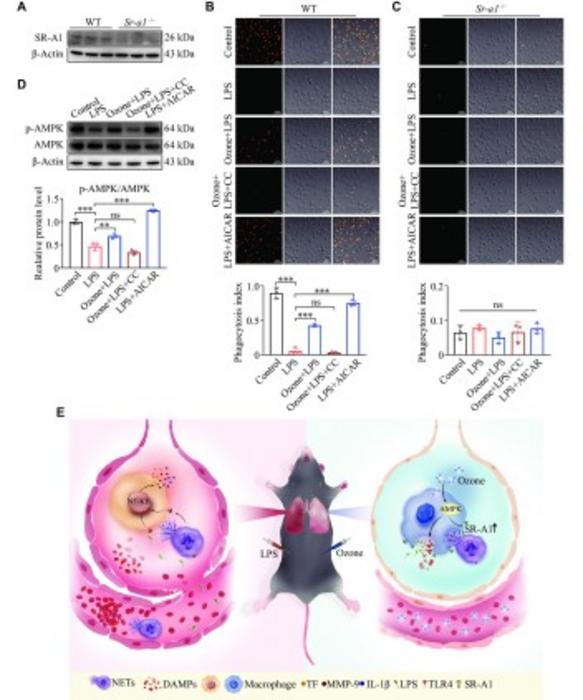In a groundbreaking advancement in the fight against sepsis-induced acute lung injury (ALI), researchers have identified medical ozone therapy as a promising new treatment strategy. This innovative therapy enhances the body’s ability to clear neutrophil extracellular traps (NETs) through the activation of the AMP-activated protein kinase (AMPK) and its upstream regulator, scavenger receptor A1 (SR-A1). The findings from this study not only bring hope to critically ill patients suffering from sepsis but also open new avenues for therapeutic interventions in the management of ALI, which has long posed a significant challenge in medical practice.
Sepsis, a life-threatening organ dysfunction triggered by infection, is associated with high mortality rates and often leads to severe complications such as ALI and acute respiratory distress syndrome (ARDS). These conditions are characterized by widespread inflammation and damage to lung tissue, significantly affecting a patient’s ability to breathe and respond effectively to treatment. The intricate relationship between inflammation, immune dysregulation, and coagulation during sepsis complicates the management of ALI, necessitating novel therapeutic strategies.
Recent research conducted by experts at Nanjing Medical University has shed light on how medical ozone can influence the AMPK/SR-A1 signaling pathway in the context of sepsis-induced ALI. The results, published in the Journal of Biomedical Research, showcase the potential of ozone therapy to improve clinical outcomes in preclinical models through its targeted action on the immune system. By reducing the formation of harmful NETs, ozone treatment facilitates the restoration of immune balance, thereby mitigating the adverse effects of sepsis and enhancing lung function.
The study’s findings are particularly noteworthy in the context of NETs, which are web-like structures released by neutrophils during immune responses. While NETs play a crucial role in capturing pathogens, their excessive formation can lead to tissue damage and exacerbate inflammation, particularly in the lungs. This research demonstrates that ozone therapy enhances macrophage phagocytosis of NETs by stimulating the AMPK pathway, a critical metabolic regulator involved in cellular responses to stress.
The role of the SR-A1 receptor becomes vital in this therapeutic landscape. The researchers observed that in mice genetically modified to lack SR-A1, the protective effects of ozone therapy were significantly diminished, underscoring the receptor’s essential contribution to mediating the therapy’s benefits. This discovery emphasizes the importance of understanding the underlying molecular mechanisms that govern the interplay between ozone therapy and the immune system.
In practical terms, the study utilized a series of intricate experiments to evaluate the effects of ozone on immune cell behavior. Macrophages exposed to ozone demonstrated enhanced clearance of NETs, leading to reduced inflammation and improved lung function in experimental models of sepsis. Furthermore, assessing the protein levels of p-AMPK and SR-A1 in bone marrow-derived macrophages (BMDMs) revealed a clear activation of the AMPK pathway following ozone treatment.
The implications of these findings extend beyond mere academic interest. If subsequent studies translate these effects into human clinical trials, medical ozone therapy could become a transformative approach to treating sepsis-related complications. Given the current limitations in effective therapeutic options for patients suffering from ALI, the potential introduction of ozone therapy offers a compelling alternative.
The principal investigator of the study, Dr. Wen-Tao Liu, articulated the significance of the research by stating that the activation of the AMPK/SR-A1 pathway through medical ozone therapy represents a paradigm shift in the management of sepsis-induced ALI. This approach not only clears harmful NETs but also restores the immune system’s functionality, ultimately leading to better patient outcomes. As such, this research lays a robust foundation for further explorations into ozone therapy as a standard treatment modality in critical care settings.
Moreover, the study contributes to the broader understanding of sepsis physiology and how therapeutic interventions can modulate immune responses. Through comprehensive evaluations of lung function, inflammatory markers, and tissue integrity following ozone exposure, the researchers illustrated that enhancing the immune system’s ability to manage sepsis can lead to increased survival rates and better overall health outcomes for patients at risk.
As medical research continues to evolve, the lessons from this study highlight not only the potential of ozone as a therapeutic agent but also the importance of interdisciplinary collaboration in addressing complex medical challenges. By unraveling the intricacies of immune system dynamics and investigating the implications of innovative therapies, researchers are paving the way for future advancements in critical care medicine.
The hope is that as this research progresses to clinical application, it will provide much-needed solutions for patients suffering from the rampant effects of sepsis. With a growing body of evidence supporting ozone therapy’s efficacy, the medical community remains optimistic about its integration into treatment protocols for sepsis-induced acute lung injury and similar conditions.
In conclusion, the study from Nanjing Medical University sets a precedent for the exploration of ozone therapy, potentially reshaping treatment approaches for sepsis and its associated complications. As further research unfolds, the focus will remain on validating these promising results in human populations and ensuring that effective and innovative strategies are available to manage this challenging condition.
Subject of Research: Medical ozone therapy for sepsis-induced acute lung injury
Article Title: Medical ozone alleviates acute lung injury by enhancing phagocytosis targeting NETs via AMPK/SR-A1 axis
News Publication Date: 29-May-2024
Web References: Journal of Biomedical Research, Study DOI
References: DOI: 10.7555/JBR.38.20240038
Image Credits: Credit: Journal of Biomedical Research
Keywords: Medical treatments, sepsis, acute lung injury, ozone therapy, macrophages, neutrophil extracellular traps, AMPK, SR-A1.
Discover more from Science
Subscribe to get the latest posts sent to your email.





